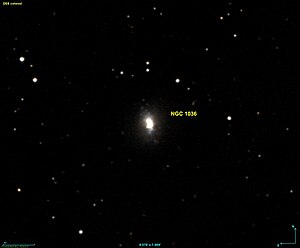NGC 1036
| Galaxy NGC 1036 / IC 1828 |
|
|---|---|

|
|
| AladinLite | |
| Constellation | Aries |
|
Position equinox : J2000.0 , epoch : J2000.0 |
|
| Right ascension | 02 h 40 m 29.0 s |
| declination | + 19 ° 17 ′ 50 ″ |
| Appearance | |
| Morphological type | P |
| Brightness (visual) | 12.7 mag |
| Brightness (B-band) | 13.7 mag |
| Angular expansion | 1.5 ′ × 1.1 ′ |
| Position angle | 2 ° |
| Surface brightness | 13.1 mag / arcmin² |
| Physical data | |
| Redshift | 0.002635 ± 0.000017 |
| Radial velocity | 790 ± 5 km / s |
|
Stroke distance v rad / H 0 |
(38 ± 3) x 10 6 ly (11.7 ± 0.8) Mpc |
| history | |
| discovery | William Herschel |
| Discovery date | November 29, 1785 |
| Catalog names | |
| NGC 1036 • IC 1828 • UGC 2160 • PGC 10127 • CGCG 462-041 • MCG + 03-07-041 • IRAS 02376 + 1904 • 2MASX J02402898 + 1917494 • Mrk 370 • GC 583 • H III 475 • h 247 • HIPASS J0240 +19 | |
NGC 1036 = IC 1828 is a dwarf galaxy of the Hubble type P in the constellation Aries on the ecliptic . It is estimated to be 38 million light years away from the Milky Way and has a diameter of about 15,000 ly.
In the same area of the sky is the galaxy IC 1832 .
The object was discovered by Wilhelm Herschel on November 29, 1785 .
Web links
Commons : NGC 1036 - Collection of Images
